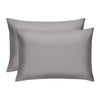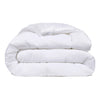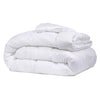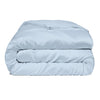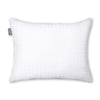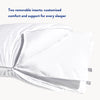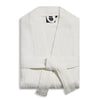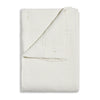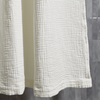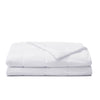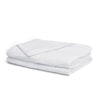The Daily Miracle
Turkish Cotton vs. Egyptian Cotton: What’s the Difference?
Published
March 26, 2023
Author
Suze Dowling

If you’re in the market for a new set of towels, you might wonder what the difference between Turkish cotton and Egyptian cotton may be. Both of these types of cotton are often used by marketers to make their brand seem more luxurious and attractive to the modern consumer.
So, what’s so special about these types of cotton anyway? Isn’t cotton pretty much the same no matter where it’s grown? Let’s dive in to find out.
What Is Cotton?
Cotton can be confusing because when it is referenced, you could be speaking of the plant or the material. Both use the name cotton; one is the plant that is grown and harvested, and the other is the fiber created after the plant is harvested. For this discussion, we’re talking mostly about cotton, the material.
Where Is Cotton Grown?
Cotton can grow worldwide but thrives in extremely hot, humid, tropical environments. Currently, the world’s largest exporter of cotton is the United States. However, countries such as China, Turkey, Peru, Egypt, and more, also grow and export large amounts of cotton.
Once the cotton is grown, it is harvested either by hand or machine. Then, it is collected into large bales, which are put through a cotton gin to clean the cotton and separate the fibers from the seeds. When this process is complete, it is shipped to the next step to be used in hundreds of different items.
What Is Turkish Cotton?
Turkish cotton is grown, you guessed it, in Turkey. It’s actually the most important raw material export in the country. Turkey's three main regions grow cotton: the Aegean region, the Mediterranean region, and the Anatolia region.
Interestingly enough, cotton is so important in Turkey that they actually are one of the world’s largest importers of cotton as well as growing their own high-quality cotton.
What Sets Turkish Cotton Apart?
Cotton is often divided into quality categories based on something called cotton staple. There are four different types, extra long staple, long staple, medium staple, and short staple. Turkish cotton is known for its quality extra long staple cotton.
The longer the staple, the longer the fibers. Length can equate to strength and softness.
Because it is so strong and soft, it makes materials that are less likely to fray, pill, or fade over time. Turkish cotton usually uses a tight weave, causing things made with Turkish cotton to be lightweight.
What Can You Make With Turkish Cotton?
Beyond just bath towels, Turkish cotton is a great material to make many other products. Most products made with Turkish cotton stay within the realm of bed and bath because it is so soft and comfortable.
Popular items made with Turkish cotton include:
- Quilts
- Bathrobes
- Bath mats
The same high-quality benefits in Turkish cotton towels can also be found in other materials made with this type of cotton.
What Is Egyptian Cotton?
Egyptian cotton is grown in Egypt, but it is also grown in other places across the globe. The history of Egyptian cotton is quite fascinating. The production of Egyptian cotton began in earnest during the Civil War. Once the United States stopped producing as much cotton, countries around the world raced to begin their own production.
Today, however, the name Egyptian cotton is more of a statement of quality than where the cotton is grown. Other countries that produce Egyptian cotton include China, Peru, and even the United States.
When it comes to towels made with Egyptian cotton, brands are actually allowed to label them Egyptian cotton with as little as five percent Egyptian cotton used in the blend. So, if you’re looking for high-quality towels, you’d be better off checking the percentage of actual Egyptian cotton than the country of origin.
Egyptian cotton is extremely high quality due to the extra-long staple. This type of cotton has fibers that are longer than other types of cotton. This makes items made with Egyptian cotton strong and heavy, making durable materials.
What Can You Make with Egyptian Cotton?
Egyptian cotton is commonly found in bedsheets and bath towels. It is also used for other products such as cushions, blankets, bedding, and even the occasional clothing item. Whatever its use, it will feel great and high-quality.
Are There Other Types of Cotton Besides Turkish and Egyptian?
While Turkish and Egyptian cotton are regarded as some of the finest cottons you can get, there are a few other types of cotton you can consider. One of the other highly rated kinds of cotton is called Pima cotton.
Mid-range cotton made with short-staple cotton is upland cotton, used in many different lower-cost materials. Some items come made with a blend of different types of cotton.
Should You Get Turkish or Egyptian Cotton Towels?
When it comes to selecting your perfect towel, it can come down to your personal preferences. Both Turkish cotton and Egyptian cotton have their pros and cons. You need to determine what is most important to you. Then, you’ll be able to find what type will fit your needs the best.
There are a few ways you can compare Turkish cotton and Egyptian cotton.
Softness
If you love a nice, soft towel, your winner may be Egyptian cotton. These two types of cotton are a bit difficult to compare because they are so similar in many ways. However, Egyptian cotton takes the crown when it comes to softness. They are known for being extremely soft and plush.
Absorbance
Which towel will absorb more water? Whether you’re using this as a bath towel or a hand towel, the amount of water it can absorb could be a deal breaker in your decision-making. Egyptian cotton absorbs more water.
However, one benefit of Turkish cotton is that it actually becomes softer and more absorbent over time.
Drying
Which towel will dry faster, Turkish cotton or Egyptian cotton? Due to the thicker weave of the Egyptian cotton towel, it does absorb more water, but it also dries slower. Turkish cotton towels dry much quicker, so Turkish cotton is a better choice if you need a quick-drying towel.
Allowing your towels to dry between uses is important in keeping mildew and other germs and bacteria at bay. Egyptian cotton may be a tricky choice if you live in a more humid climate because it can also absorb humidity.
Durability
Which type of cotton is more durable? Surprisingly, both types of cotton are very durable compared to other fabrics. Because both Turkish cotton and Egyptian cotton are made with long or extra-long staple cotton, the fibers are long and strong, creating a more durable towel.
Decision Time
Now that you’ve weighed the pros and cons of Turkish and Egyptian cotton, all that’s left is to make your choice! Would you prefer a thick, plush towel that takes longer to dry? If so, go with Egyptian cotton.
Do you value a quick-drying towel that will get even softer over time? Then a Turkish cotton towel might be for you. Either way, you’re sure to love your new towels.
Sources:
Cotton Sector at a Glance | USDA
How Often Should You Wash Your Towels? | Benefits and Tips | Healthline


